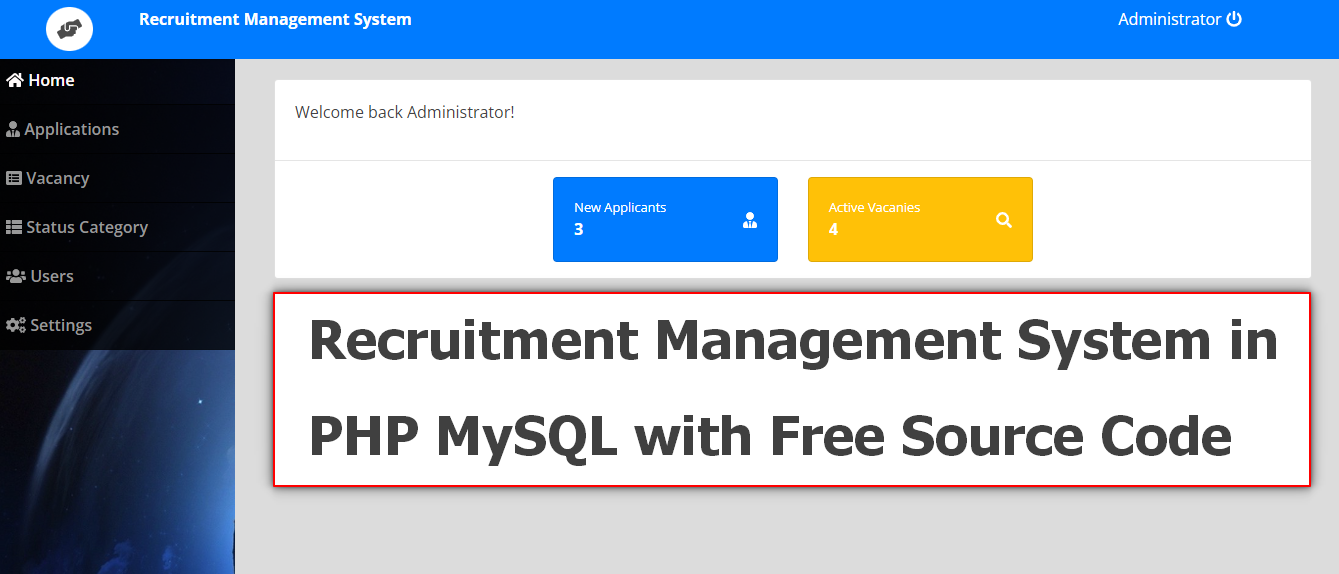The Recruitment Management System in PHP is a simple web application developed in PHP My SQL database, using bootstrap, HTML, CSS, JavaScript, modal, and ajax, this system consists of admin and staff, the admin can manage all staff such as edit, update, delete, and add new user, the staff is represented as a user, and can manage data entry from online applicants, the system is simple and easy to understand.
How To setup the Project

The following is how the Recruitment Management System in PHP :
To begin, this recruitment management system requires system user credentials to access the system’s admin side, which may be obtained by logging into the system.
Second, the system administrator or staff will populate the list of recruitment status categories in order to properly organize the list of candidates based on their recruitment status.
Table of Contents
Subscribe YouTube For Latest Update Click Here
50 + PHP Projects with Source Code
Recruitment Management System
| Project Name | Recruitment Management System in PHP |
|---|---|
| Language Used | PHP5.6, PHP7.x |
| Database | MySQL 5.x |
| User Interface Design | HTML, AJAX,JQUERY,JAVASCRIPT |
| Web Browser | Mozilla, Google Chrome, IE8, OPERA |
| Software | XAMPP / Wamp / Mamp/ Lamp (anyone) |
| Last Updated | Last week |
How to setup this project
- Step 1st. Download xampp
- Step 2nd. Text editor vs Code or Sublime
- Step 3rd. Download the zip file/ Download winrar
- Step 4th. Extract the file and copy “Recruitment_Management_System” folder
- Step 5th. Paste inside root directory/ where you install xampp local disk C: and xampp/htdocs,
- Step 6th. Open PHPMyAdmin http://localhost/phpmyadmin
- Step 7th. Create database name recruitment_db
- Step 8th. Import recruitment_db.sql file given inside the zip package in SQL file folder
- Step 9th. Run the script http://localhost/Recruitment_Management_System
- Step 10th. Password: Username: admin / Password: admin123
New real time Java Projects Check : java Projects
The Recruitment Management System operates as follows:
User Authentication:
To access the administrative side of the system, individuals must provide valid user credentials by logging into the platform.
Recruitment Status Categories:
System administrators or authorized staff are responsible for creating and maintaining a structured list of recruitment status categories. This categorization helps in efficiently organizing applicants based on their respective recruitment status.
Vacancy Position Management:
Administrators and staff members also play a crucial role in managing the list of available job positions within their organization. They include comprehensive descriptions of each position, ensuring potential applicants have a clear understanding of the available opportunities.
Application Process:
Prospective applicants visit the company’s recruitment website to identify and apply for their desired positions. Once a suitable position is located, applicants can access complete position details and submit their application by clicking the “Apply Now” button. The application form is then displayed, allowing applicants to enter the necessary information and upload their resumes. Alternatively, for those applying in person at the company’s location, the administrative staff can facilitate the same process.
Recruitment Status Management:
Administrators and staff members have the capability to update and manage the recruitment status of each applicant throughout the various stages and processes required by the company’s recruitment procedures. This ensures a systematic and organized approach to candidate evaluation and selection.
Feature

- Admin:
- Dashboard: In this section, admin can see all detail in brief like Total Company Registered, Total User (Candidates) Registered and Total Vacancy Listed.
- Total Registered Company: In this section, admin can view detail of the registered company.
- Total Registered Users: In this section, admin can view detail of users.
- Pages: In this section, the admin can manage about us and contact us pages.
- Reports: In this section admin can view how many companies have been registered in a particular period and also view how many vacancy counts listed by a particular company in particular periods.

- Registered User Features
- Dashboard: In this section, company can see all detail in brief like Total Number of applications received, Total number of new applications, Total number selected application, Total number of rejected applications.
- Post Vacancy: In this section, company can manage job posting (Add/Manage).
- Job Application: In this section, company can view total new applications receive, total sorted applications and total rejected applications and the company also have the right to sort application and reject the application and this selected and rejected message send to candidates.
- Reports: In this section, company can view job posting in particular periods and also see how many application has been received in a particular period.
📝 Note: Don’t hesitate to connect with us if you’re in need of the source code. We’re here to provide you with the complete source code, along with all essential components like databases and project reports, complete with diagrams. Furthermore, we offer a comprehensive STEP-BY-STEP configuration guide to help you smoothly set up your project.
Project Screenshots:-



Download Project :-Click Here
Tags:-
Campus Recruitment ManagementCampus, Recruitment Management projectCampus .Recruitment Management SystemCampus, Recruitment Management System in php ,Campus Recruitment Management System Project ,Campus Recruitment Management System using PHP and MySQL






